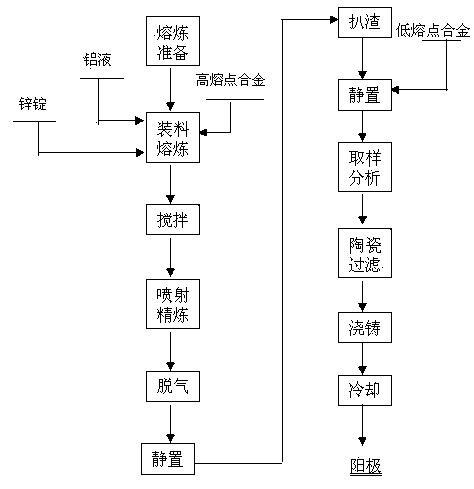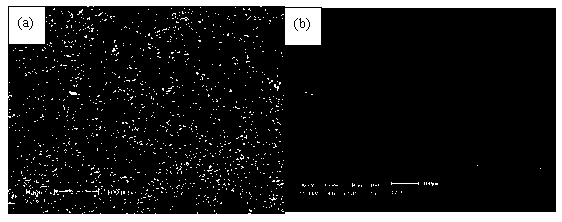Casting method of aluminum alloy sacrificial anode
A sacrificial anode and aluminum alloy melt technology, which is applied in the field of corrosion and protection, can solve the problems of reduced current efficiency, general degassing effect, and poor ability to remove oxide inclusions, so as to avoid the influence of anode performance and shorten the melting time , The effect of shortening the melting time
- Summary
- Abstract
- Description
- Claims
- Application Information
AI Technical Summary
Problems solved by technology
Method used
Image
Examples
Embodiment 1
[0029] (2) Argon loading composition is 39% NaCl+50%KCl+4.4%CaF 2 +6.6%Na 3 AlF 6 The refining agent is spray-refined on the aluminum alloy liquid, the refining temperature is 720°C, the amount of refining agent accounts for 0.6% of the total charge, and the refining time is 20 minutes to obtain a refined aluminum alloy melt;
[0030] (3) After refining, pass argon gas into the aluminum alloy melt for degassing. The degassing time is 7 minutes. The degassed aluminum alloy melt is allowed to stand for 20 minutes, and then use a slag removal tool to remove the surface of the aluminum alloy melt. oxidation scum;
[0031] (4) Add low-melting-point metal element In into the aluminum alloy melt after slag removal, In is pressed in with a bell jar in the form of high-purity aluminum foil wrapping, and the pressing time is 1 minute;
[0032] (5) After the low-melting-point metal is pressed in, electromagnetically stir the melt for 5 minutes, and then perform ceramic filtration to o...
Embodiment 2
[0041] (2) Argon loading composition is 39% NaCl+50%KCl+4.4%CaF 2 +6.6%Na 3 AlF 6 The refining agent is spray-refined on the aluminum alloy liquid, the refining temperature is 740°C, the amount of refining agent accounts for 0.3% of the total charge, and the refining time is 30 minutes to obtain a refined aluminum alloy melt;
[0042] (3) After refining, pass argon gas into the aluminum alloy melt for degassing. The degassing time is 15 minutes. After degassing, the aluminum alloy melt is left to stand for 5 minutes, and then use a slag removal tool to remove the surface of the aluminum alloy melt. oxidation scum;
[0043] (4) Add low-melting-point metal elements In and Mg to the aluminum alloy melt after slag removal, and press it in with a bell jar in the form of high-purity aluminum foil wrapping, and the pressing time is 2 minutes;
[0044] (5) After the low-melting-point metal is pressed in, electromagnetically stir the melt for 15 minutes, and then perform ceramic fil...
Embodiment 3
[0053] (2) Argon loading composition is 39% NaCl+50%KCl+4.4%CaF 2 +6.6%Na 3 AlF 6 The refining agent is spray-refined on the aluminum alloy liquid, the refining temperature is 780°C, the amount of refining agent accounts for 0.5% of the total charge, and the refining time is 5 minutes to obtain a refined aluminum alloy melt;
[0054] (3) After refining, pass argon gas into the aluminum alloy melt for degassing. The degassing time is 10 minutes. The degassed aluminum alloy melt is left to stand for 10 minutes, and then use a slag removal tool to remove the surface of the aluminum alloy melt. oxidation scum;
[0055] (4) Add low-melting-point metal elements In and Cd to the aluminum alloy melt after slag removal, and press it in with a bell jar in the form of high-purity aluminum foil wrapping, and the pressing time is 1.5 minutes;
[0056] (5) After the low-melting-point metal is pressed in, electromagnetically stir the melt for 25 minutes, and then perform ceramic filtratio...
PUM
| Property | Measurement | Unit |
|---|---|---|
| current efficiency | aaaaa | aaaaa |
Abstract
Description
Claims
Application Information
 Login to View More
Login to View More - R&D
- Intellectual Property
- Life Sciences
- Materials
- Tech Scout
- Unparalleled Data Quality
- Higher Quality Content
- 60% Fewer Hallucinations
Browse by: Latest US Patents, China's latest patents, Technical Efficacy Thesaurus, Application Domain, Technology Topic, Popular Technical Reports.
© 2025 PatSnap. All rights reserved.Legal|Privacy policy|Modern Slavery Act Transparency Statement|Sitemap|About US| Contact US: help@patsnap.com


